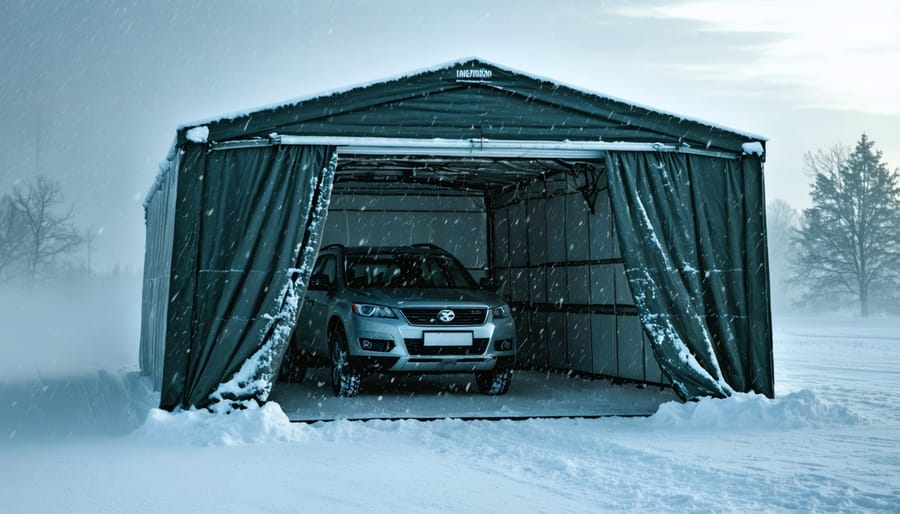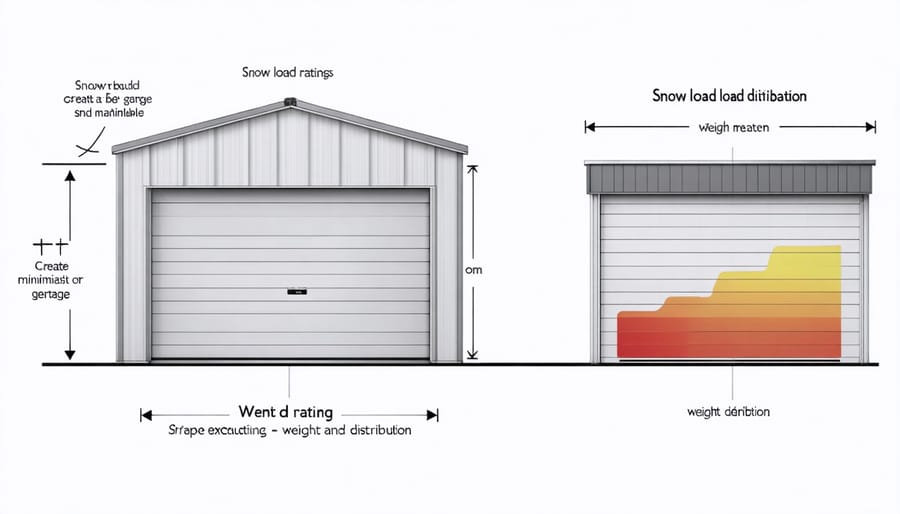Shield Your Vehicle: How Portable Garages Stand Up to Brutal Winter Storms

Protect your vehicle from harsh winter conditions with a wind and snow rated portable garage – an investment that combines durability with convenience. These engineered shelters withstand significant snow loads and wind forces while offering quick assembly and seasonal mobility. Unlike traditional garages, these weather-resistant structures feature reinforced frames, heavy-duty covers, and specialized anchoring systems designed specifically for winter challenges.
Modern portable garages rated for snow and wind incorporate essential features like UV-protected covers, powder-coated steel frames, and patented stabilization systems that prevent collapse under heavy snow accumulation. Leading manufacturers now offer models tested to withstand winds up to 80 mph and snow loads exceeding 30 pounds per square foot – crucial specifications for regions experiencing severe winter weather.
For homeowners seeking reliable vehicle protection without permanent construction, these robust shelters provide a practical solution that balances strength with portability. Whether safeguarding your car, boat, or recreational vehicle, a properly rated portable garage ensures peace of mind throughout the winter months while maintaining the flexibility to relocate or store during warmer seasons.
Understanding Snow and Wind Ratings for Portable Garages
Snow Load Capacity
Snow load capacity is a crucial rating that determines how much weight from accumulated snow your portable garage can safely support. Most quality portable garages are designed to handle between 20 to 35 pounds per square foot of snow, though some heavy-duty models can withstand up to 50 pounds per square foot. This rating becomes especially important in regions that experience significant snowfall.
To put this in perspective, fresh snow typically weighs about 3-5 pounds per square foot, while packed or wet snow can weigh up to 20 pounds per square foot. When choosing your portable garage, consider your local winter weather patterns and average snowfall amounts to ensure adequate protection.
For safety, look for models with peaked or sloped roofs that naturally encourage snow to slide off rather than accumulate. Many snow-rated portable garages also feature reinforced frames and additional support poles to handle the extra weight. Remember that regular snow removal from your garage’s roof is essential, even with a high snow load rating, to prevent potential structure damage and ensure long-term durability.

Wind Resistance Ratings
Understanding wind resistance ratings is crucial when selecting a portable garage that can withstand challenging weather conditions. These ratings indicate the maximum wind speeds your structure can safely handle, typically ranging from 65 mph to 100+ mph for high-quality models. A portable garage with a proper wind-resistant structural design incorporates features like reinforced steel frames, heavy-duty anchoring systems, and aerodynamic profiles.
Most standard portable garages are rated for winds up to 80 mph, which is suitable for many regions. However, if you live in an area prone to strong storms or hurricanes, consider models rated for 90 mph or higher. These ratings are determined through rigorous testing and must comply with local building codes and standards.
Remember that proper installation significantly impacts wind resistance. Even a highly-rated structure can fail if not correctly anchored or assembled. Look for models with multiple anchor points, cross-bracing, and reinforced corners to ensure maximum stability during windy conditions. When in doubt, always choose a higher wind rating than you think you’ll need – it’s better to be over-prepared than risk damage to your structure and stored items.
Key Features of Winter-Ready Portable Garages
Frame Construction
The backbone of any wind and snow rated portable garage lies in its robust frame construction. Most high-quality units feature heavy-duty steel frames, typically made from 1.5- to 2-inch diameter galvanized steel tubing. This industrial-grade material provides the essential strength needed to withstand harsh weather conditions while resisting rust and corrosion.
The frame’s design usually incorporates a truss-style roof system, where multiple support beams create triangular patterns for superior weight distribution. This architectural approach helps prevent snow accumulation and allows the structure to bear substantial snow loads without buckling.
Key reinforcement points include double-layered connectors at crucial joints and additional cross-bracing along the sides and roof. Many premium models feature patented stabilizer blocks at base points, which significantly enhance ground anchoring and overall stability during high winds.
The spacing between frame members is also strategically calculated, typically ranging from 4 to 6 feet apart. This optimal spacing ensures the cover material receives adequate support while maintaining the structure’s integrity against external pressures. Some advanced models include adjustable legs to accommodate uneven terrain, ensuring proper weight distribution regardless of the installation surface.
For enhanced durability, look for frames featuring powder-coated finishes, which provide an extra layer of protection against moisture and UV damage. This treatment significantly extends the frame’s lifespan and maintains its structural integrity through multiple seasons.

Cover Materials
The cover material of your wind and snow rated portable garage plays a crucial role in its durability and weather resistance. Most winter-resistant portable garages feature triple-layer polyethylene covers, which offer superior protection against harsh elements. These covers are typically UV-treated and waterproof, ensuring your vehicle stays protected from sun damage while keeping moisture at bay.
The best covers incorporate rip-stop technology, preventing small tears from expanding into larger holes. Look for covers with a minimum thickness of 180 GSM (grams per square meter) for adequate winter protection. Premium models often feature special weatherproofing techniques like heat-sealed seams and reinforced stress points, which significantly enhance their snow-bearing capacity.
Many quality covers also include a fade-resistant treatment, maintaining their appearance throughout multiple seasons. The most effective winter-rated covers feature a slightly textured surface that helps shed snow more efficiently, preventing dangerous accumulation on top of the structure.
For added durability, some manufacturers incorporate specialized webbing along the edges and corners, providing extra reinforcement where the cover meets the frame. This design element helps distribute tension evenly across the entire surface, reducing the risk of tears during high winds or heavy snow loads.
Remember to check that your cover includes proper tie-down mechanisms, such as ratchet tensioners or heavy-duty straps, to ensure it remains securely fastened throughout winter storms.
Installation Tips for Maximum Winter Protection
Proper Anchoring Methods
Proper anchoring is crucial for ensuring your wind and snow rated portable garage stays secure during harsh weather conditions. Start with a secure foundation installation, whether it’s a concrete pad, crushed stone, or reinforced ground cover. For maximum stability, use auger-style anchors that penetrate at least 30 inches into the ground at each corner and midpoint of your structure.
Consider implementing a dual-anchoring system: ground anchors combined with weight-based stabilizers. Heavy-duty ratchet straps should secure the frame to the anchors, creating a tight, unified structure. For areas with heavy snowfall, additional cross-bracing and central support anchors are recommended to prevent collapse under snow weight.
Don’t overlook the importance of proper tensioning – your straps should be snug but not overtightened, as this could damage the frame. Install anchor points at 45-degree angles from the structure’s base for optimal resistance against both uplift and lateral forces. For added security, consider using concrete blocks or heavy-duty sandbags along the base perimeter.
Regular anchor inspection is essential, especially after storms or significant temperature changes. Check for any loose connections, rust, or soil erosion around anchor points. During winter, clear snow accumulation regularly to prevent excess weight strain on your anchoring system.
Remember to comply with local building codes when installing anchors, as requirements vary by region. Many manufacturers provide specific anchoring kits designed for their portable garages – using these recommended systems helps ensure proper fit and maximum effectiveness.

Additional Winter Reinforcement
Even the most robust wind and snow rated portable garage can benefit from additional reinforcement during severe winter weather. Start by adding extra anchoring points beyond the standard kit – consider installing auger-style anchors every 4-6 feet along both sides of the structure. These provide superior hold in frozen ground and resist uplift from strong winds.
Creating a snow barrier around your portable garage can significantly reduce drift accumulation. Position sandbags or snow fencing strategically to redirect snow away from the walls and entrance. For added stability, install cross-bracing cables between the frame’s upper supports to prevent swaying during heavy winds.
Consider adding a secondary tarp layer inside your portable garage, creating an insulating air pocket that helps prevent condensation and adds structural support. This double-layer system also provides backup protection if the outer cover sustains damage during storms.
For areas prone to heavy snow loads, install additional support poles in the center of the structure, positioning them every 6-8 feet. Combined with regularly brushing snow off the roof using a roof rake, these supports help prevent collapse under wet, heavy snow.
Monitor your portable garage during winter storms and conduct quick inspections after severe weather. Pay special attention to cover tension, anchor points, and frame connections. Keep spare parts and repair materials on hand for emergency fixes, including extra clips, bungee cords, and patch kits for the cover.
Remember to clear snow and ice from the entrance regularly to maintain easy access and prevent damage to the door panels or zippers. These simple precautions can significantly extend your portable garage’s lifespan and enhance its winter performance.
Maintenance During Winter Months
Snow Removal Strategies
Regular managing snow accumulation is crucial for maintaining your portable garage’s integrity during winter months. Use a roof rake with an extended handle to safely remove snow from the ground, working from the edges toward the center. Never climb onto the structure, as this can damage the cover and frame while putting you at risk.
For heavy snowfall, consider installing a snow shield – a smooth, slightly angled surface that helps snow slide off naturally. Keep the area around your portable garage clear of snow drifts, which can create moisture problems and stress the walls. A snow blower path around the perimeter provides easy access and prevents snow from piling up against the sides.
Set up preventive measures before winter arrives. Position your portable garage away from areas where snow typically drifts, and ensure proper tension in the cover to prevent snow pockets from forming. Some owners find success with heat cables along the roof edges, though this requires careful installation and access to power.
If ice forms, avoid using sharp tools that could tear the cover. Instead, use calcium chloride or similar ice-melt products that are safe for fabric covers. Remember to check your structure after each significant snowfall, as early intervention prevents potential collapse and extends the life of your portable garage.
Regular Inspection Points
Regular maintenance is key to ensuring your wind and snow rated portable garage remains secure and protective throughout the seasons. Perform these essential checks at least monthly, and always after severe weather events:
Check all anchor points and ensure they’re firmly secured to the ground. Look for any signs of pulling or loosening, particularly at corner positions. Tighten as needed, and replace any damaged components immediately.
Inspect the frame structure for any bending, warping, or stress points. Pay special attention to joints and connection points where different frame pieces meet. During winter months, clear any accumulated snow from the roof before it becomes too heavy.
Examine the cover material thoroughly for tears, stretching, or wear spots. Small tears should be patched promptly to prevent them from expanding. Check that the cover remains properly tensioned across the frame, adjusting straps or ties as necessary.
Review door functionality by testing zippers, checking for smooth operation, and ensuring all closures work properly. Door areas often experience the most wear and tear from daily use.
Look for any water pooling on the roof or sides, which could indicate sagging or improper tensioning. Adjust the cover as needed to maintain proper watershed. During winter, monitor ice dam formation along the edges.
Inspect the base area for proper drainage and ensure no standing water is collecting around the structure. Clear any debris that might block water flow or cause damage to the foundation area.
These regular checks will help extend your portable garage’s lifespan and maintain its protective capabilities throughout all seasons.
Choosing the right wind and snow rated portable garage is a crucial decision that can protect your valuable vehicles and equipment throughout harsh weather conditions. Throughout this guide, we’ve explored the essential features that make these structures reliable winter storage solutions, from robust steel frames to reinforced polyethylene covers and proper anchoring systems.
Remember that the key to success lies in selecting a portable garage rated for your specific climate conditions. Look for models with snow load ratings appropriate for your region and wind resistance capabilities that match local weather patterns. The investment in a higher-rated structure often pays off through improved durability and peace of mind.
Installation and maintenance are equally important factors in ensuring your portable garage performs as intended. Take time to prepare a level foundation, follow manufacturer guidelines precisely, and regularly inspect your structure for signs of wear or stress. During heavy snow events, remove accumulation promptly to prevent overloading.
For optimal results, consider additional reinforcement options like extra anchoring points or support poles during severe weather. While portable garages offer excellent temporary shelter, they require proper care and attention to maintain their protective capabilities.
By following these guidelines and maintaining your portable garage diligently, you’ll have a reliable shelter that stands up to winter’s challenges while protecting your vehicles and equipment for years to come.

